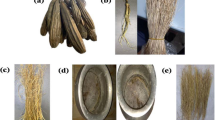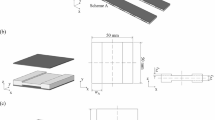Abstract
The soundproofing properties of polycarbonate (PC)/nanoclay and PC/nanosilica nanocomposites were studied through testing and theoretical analysis. Nanocomposite sheets with a 3 mm thickness were fabricated by direct hot-compression molding process. The nanoclay and nanosilica particles were incorporated into the PC matrix by a twin-screw extruder. The dispersion efficiency of 1, 3 and 5 wt% nanoclay and nanosilica in the PC matrix was investigated by transmission electron microscopy. Dynamic mechanical analysis was performed for evaluation of mechanical properties of nanocomposites. Sound transmission loss (STL) was measured by an impedance tube over the frequency range of 1600–6300 Hz, and further employed in sound proofing characterizations of nanocomposites. A new finite element model was developed to model the sound transmission loss in impedance tube test. The results showed that the PC/3 wt% nanoclay and 3 wt% nanosilica nanocomposites had an average maximum increase of 5.5 and 6 dB in STL values in the stiffness control region (1600–3600 Hz), respectively. On the other hand, the PC/3 wt% nanoclay and PC/3 wt% nanosilica nanocomposites showed the same sound isolation characteristics in the frequency range of 1600–3600 Hz. In addition, the finite element model developed for modeling the sound transmission loss in the impedance tube demonstrated a good correlation between the theoretical curves and the experimental results in the stiffness control region for both nanocomposites.








Similar content being viewed by others
References
Lee FC, Chen WH (2001) Acoustic transmission analysis of multi-layer absorbers. J Sound Vib 248:621–634
Ivansson SM (2006) Sound absorption by viscoelastic coatings with periodically distributed cavities. J Acoust Soc Am 119:3558–3567
Natsuki T, Ni QQ (2014) Theoretical analysis of sound transmission loss through graphene sheets. Appl Phys Lett 105:201907
Oudich M, Zhou X, Assouar MB (2014) General analytical approach for sound transmission loss analysis through a thick metamaterial plate. J Appl Phys 116:193509
Toyoda M, Takahashi D (2008) Sound transmission through a microperforated-panel structure with subdivided air cavities. J Acoust Soc Am 124:3594–3603
Mu RL, Toyoda M, Takahashi D (2011) Improvement of sound insulation performance of multilayer windows by using microperforated panel. Acoust Sci Technol 32:79–81
Bravo T, Maury C, Pinhède C (2012) Sound absorption and transmission through flexible micro-perforated panels backed by an air layer and a thin plate. J Acoust Soc Am 131:3853–3863
Mahjoob MJ, Mohammadi N, Malakooti S (2012) Analytical and experimental evaluation of magnetic field effect on sound transmission loss of MR-based smart multi-layered panels. Appl Acoust 73:614–623
Huang C, Nutt S (2011) An analytical study of sound transmission through unbounded panels of functionally graded materials. J Sound Vib 330:1153–1165
Chandra N, Raja S, Gopal KN (2014) Vibro-acoustic response and sound transmission loss analysis of functionally graded plates. J Sound Vib 333:5786–5802
Ng C, Hui C (2008) Low frequency sound insulation using stiffness control with honeycomb panels. Appl Acoust 69:293–301
Tadeu AJ, Mateus DM (2001) Sound transmission through single, double and triple glazing: experimental evaluation. Appl Acoust 62:307–325
Quirt J (1982) Sound transmission through windows: I. single and double glazing. J Acoust Soc Am 72:834–844
Quirt J (1983) Sound transmission through windows: II. double and triple glazing. J Acoust Soc Am 74:534–542
Duquesne S, Jimenez M, Bourbigot S (2014) Aging of the flame-retardant properties of polycarbonate and polypropylene protected by an intumescent coating. J App Polym Sci 131:39566
Beloshenko VA, Voznyak AV, Voznyak YV (2015) Effects of equal-channel, multiple-angular extrusion on the physical and mechanical properties of glassy polymers. J Appl Polym Sci 132:24180
Baick IH, Yang WJ, Ahn YG, Song KH, Choi KY (2015) Structure and properties of ultra-high molecular weight bisphenol a polycarbonate synthesized by solid-state polymerization in amorphous microlayers. J Appl Polym Sci 132:41609
Mallakpour S, Behranvand V (2016) Nanocomposites based on biosafe nano ZnO and different polymeric matrixes for antibacterial, optical, thermal and mechanical applications. Eur Polym J 84:377–403
Reddy KR, Lee KP, Gopalan AI (2007) Self-assembly directed synthesis of poly (ortho-toluidine)-metal (gold and palladium) composite nanospheres. J Nanosci Nanotechnol 7:3117–3125
Choi SH, Kim DH, Raghu AV, Reddy KR, Lee HI, Yoon KS, Jeong HM, Kim BK (2012) Properties of graphene/waterborne polyurethane nanocomposites cast from colloidal dispersion mixtures. J Macromol Sci B 51:197–207
Verdejo R, Stämpfli R, Alvarez-Lainez M, Mourad S, Rodriguez-Perez M, Brühwiler P, Shaffer M (2009) Enhanced acoustic damping in flexible polyurethane foams filled with carbon nanotubes. Compos Sci Technol 69:1564–1569
Verdejo R, Saiz-Arroyo C, Carretero-Gonzalez J, Barroso-Bujans F, Rodriguez-Perez MA, Lopez-Manchado MA (2008) Physical properties of silicone foams filled with carbon nanotubes and functionalized graphene sheets. Eur Polym J 44:2790–2797
Ni QQ, Lu E, Kurahashi N, Kurashiki K, Kimura T (2008) Development of insulation sheet materials and their sound characterization. Adv Compos Mater 17:25–40
Kim MS, Yan J, Joo KH, Pandey JK, Kang YJ, Ahn SH (2013) Synergistic effects of carbon nanotubes and exfoliated graphite nanoplatelets for electromagnetic interference shielding and soundproofing. J Appl Polym Sci 130:3947–3951
Ahmadi S, Nassiri P, Ghasemi I, Esmaeilpoor MRM (2015) Sound transmission loss through nanoclay-reinforced polymers. Iran Polym J 24:641–649
Lee JC, Hong YS, Nan RG, Jang MK, Lee CS, Ahn SH, Kang YJ (2008) Soundproofing effect of nano particle reinforced polymer composites. J Mech Sci Technol 22:1468–1474
Liang JZ, Jiang XH (2012) Soundproofing effect of polypropylene/inorganic particle composites. Compos B 43:1995–1998
Kim MS, Yan J, Kang KM, Joo KH, Pandey JK, Kang YJ, Ahn SH (2013) Soundproofing properties of polypropylene/clay/carbon nanotube nanocomposites. J Appl Polym Sci 130:504–509
Kim MS, Yan J, Kang KM, Joo KH, Kang YJ, Ahn SH (2013) Soundproofing ability and mechanical properties of polypropylene/exfoliated graphite nanoplatelet/carbon nanotube (PP/xGnP/CNT) composite. Int J Precis Eng Man 14:1087–1092
Saarikoski I, Suvanto M, Pakkanen TA (2009) Modification of polycarbonate surface properties by nano-, micro-, and hierarchical micro–nanostructuring. Appl Surf Sci 255:9000–9005
Carrion F, Sanes J, Bermúdez MD (2007) Influence of ZnO nanoparticle filler on the properties and wear resistance of polycarbonate. Wear 262:1504–1510
Carrión FJ, Arribas A, Bermúdez MD, Guillamon A (2008) Physical and tribological properties of a new polycarbonate-organoclay nanocomposite. Eur Polym J 44:968–977
Suin S, Maiti S, Shrivastava NK, Khatua B (2014) Mechanically improved and optically transparent polycarbonate/clay nanocomposites using phosphonium modified organoclay. Mater Des 54:553–563
Keshavarz R, Ohadi A (2013) Effects of compression on sound absorption of transversely isotropic fibrous materials at oblique incidence. Appl Acoust 74(3):383–395
Kinsler LE, Frey AR, Coppens AB, Sanders JV (1999) Fundamentals of acoustics, 4th edn. Wiley, New York
Mase GT, Smelser RE, Mase GE (2009) Continuum mechanics for engineers. CRC, New York
Panneton R, Atalla N (1996) Numerical prediction of sound transmission through finite multilayer systems with poroelastic materials. J Acoust Soc Am 100:346–354
Sabet SM, Ohadi A (2016) Experimental and theoretical investigation of sound transmission loss for polycarbonate, poly (methyl methacrylate), and glass. J Appl Polym Sci 133:42988
Author information
Authors and Affiliations
Corresponding author
Appendix
Appendix
The stiffness matrix \(\left[ K \right]^{(e)}\), mass matrix \(\left[ M \right]^{(e)}\), displacement vector \(\left[ u \right]^{(e)}\) and force vector \(\left[ f \right]^{(e)}\) are defined as follows:
As an example, below is the two matrix elements of the stiffness matrix \(\left[ K \right]_{8 \times 8}^{(e)}\):
Rights and permissions
About this article
Cite this article
Sabet, S.M., Keshavarz, R. & Ohadi, A. Sound isolation properties of polycarbonate/clay and polycarbonate/silica nanocomposites. Iran Polym J 27, 57–66 (2018). https://doi.org/10.1007/s13726-017-0585-2
Received:
Accepted:
Published:
Issue Date:
DOI: https://doi.org/10.1007/s13726-017-0585-2




